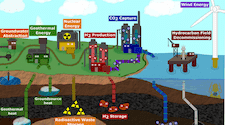
The UK Carbon Capture and Storage Research Centre (UKCCSRC) held a virtual conference on 7ᵗʰ-8ᵗʰ September 2021, with a dedicated poster session held on 16ᵗʰ November 2021, entitled “Delivering on COP26: CCS across the world”. The conference involved several prominent contributors who outlined significant initiatives to investigate major carbon capture, usage and storage (CCUS) deployment as a part of a strategy to meet a national Net Zero Emissions target by 2050 and keep a global average temperature increase of 1.5 degrees Celsius within reach.
Renato Zagorščak attended the Conference and presented a poster titled “Well Decommissioning in the Energy Transition”. Well decommissioning is important to ensure that wells perform as required during any operations involving carbon capture and storage (CCS), hydrogen storage, radioactive waste disposal, and geothermal heat extraction. Well decommissioning has a major role to play in the energy transition, as site operators will need to justify the expectation of secure containment to regulators and other stakeholders. An understanding of the long-term behaviour of the barriers and their interactions with other materials is required to provide confidence in their safety functions within an environmental safety case for a given scheme.
Quintessa specialises in such areas and has been providing associated consultancy and research for over 20 years. Quintessa has a “data to decisions” perspective on decision-making and helps organisations make key decisions with confidence through tools such as decision trees, bow-ties, and options appraisal and optimisation.
Quintessa has expertise in using third-party computer packages such as COMSOL Multiphysics, GoldSim, PHREEQC and Geochemist’s Workbench, as well as using our own in-house packages such as QPAC, TESLA and AMBER. Quintessa has undertaken projects involving geochemical modelling, coupled modelling of THMC processes, modelling long-term behaviour of natural and engineered barriers, as well as fluid migration from underground storage and disposal facilities.